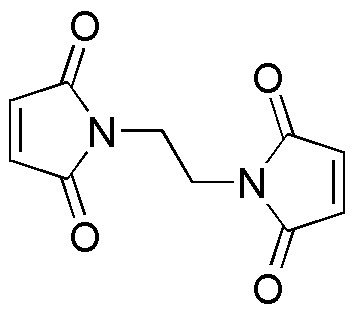1,2-Bis-maleimidoethane is widely utilized in research focused on:
- Polymer Chemistry: This compound serves as a crosslinking agent in the synthesis of thermosetting polymers, enhancing their mechanical properties and thermal stability. It is particularly beneficial in creating durable materials for automotive and aerospace applications.
- Biomedical Applications: It is used in the development of biocompatible materials for drug delivery systems and tissue engineering, allowing for controlled release of therapeutics and improved integration with biological tissues.
- Adhesives and Sealants: The compound is incorporated into formulations for high-performance adhesives, providing excellent bonding strength and resistance to environmental factors, making it ideal for construction and manufacturing industries.
- Electronics: In the electronics sector, it is utilized in the production of encapsulants and coatings that protect sensitive components from moisture and mechanical stress, enhancing the longevity and reliability of electronic devices.
- Textile Industry: This chemical is applied in the treatment of fabrics to improve their resistance to wrinkling and staining, offering consumers higher quality and longer-lasting textiles.
General Information
Properties
Safety and Regulations
Applications
1,2-Bis-maleimidoethane is widely utilized in research focused on:
- Polymer Chemistry: This compound serves as a crosslinking agent in the synthesis of thermosetting polymers, enhancing their mechanical properties and thermal stability. It is particularly beneficial in creating durable materials for automotive and aerospace applications.
- Biomedical Applications: It is used in the development of biocompatible materials for drug delivery systems and tissue engineering, allowing for controlled release of therapeutics and improved integration with biological tissues.
- Adhesives and Sealants: The compound is incorporated into formulations for high-performance adhesives, providing excellent bonding strength and resistance to environmental factors, making it ideal for construction and manufacturing industries.
- Electronics: In the electronics sector, it is utilized in the production of encapsulants and coatings that protect sensitive components from moisture and mechanical stress, enhancing the longevity and reliability of electronic devices.
- Textile Industry: This chemical is applied in the treatment of fabrics to improve their resistance to wrinkling and staining, offering consumers higher quality and longer-lasting textiles.
Documents
Safety Data Sheets (SDS)
The SDS provides comprehensive safety information on handling, storage, and disposal of the product.
Product Specification (PS)
The PS provides a comprehensive breakdown of the product’s properties, including chemical composition, physical state, purity, and storage requirements. It also details acceptable quality ranges and the product's intended applications.
Certificates of Analysis (COA)
Search for Certificates of Analysis (COA) by entering the products Lot Number. Lot and Batch Numbers can be found on a product’s label following the words ‘Lot’ or ‘Batch’.
*Catalog Number
*Lot Number
Certificates Of Origin (COO)
This COO confirms the country where the product was manufactured, and also details the materials and components used in it and whether it is derived from natural, synthetic, or other specific sources. This certificate may be required for customs, trade, and regulatory compliance.
*Catalog Number
*Lot Number
Safety Data Sheets (SDS)
The SDS provides comprehensive safety information on handling, storage, and disposal of the product.
DownloadProduct Specification (PS)
The PS provides a comprehensive breakdown of the product’s properties, including chemical composition, physical state, purity, and storage requirements. It also details acceptable quality ranges and the product's intended applications.
DownloadCertificates of Analysis (COA)
Search for Certificates of Analysis (COA) by entering the products Lot Number. Lot and Batch Numbers can be found on a product’s label following the words ‘Lot’ or ‘Batch’.
*Catalog Number
*Lot Number
Certificates Of Origin (COO)
This COO confirms the country where the product was manufactured, and also details the materials and components used in it and whether it is derived from natural, synthetic, or other specific sources. This certificate may be required for customs, trade, and regulatory compliance.


